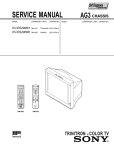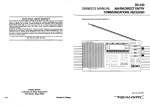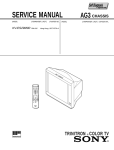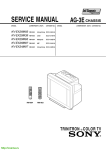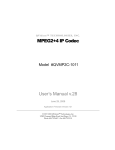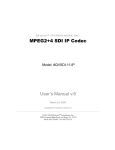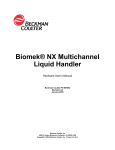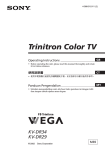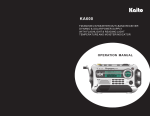Download Belkin 157 User's Manual
Transcript
The official audio standard for analog television broadcasting in Australia. It is a technique of implementing stereo or dualmono audio for NTSC and PAL video. One FM subcarrier transmits a L+R signal, and a second FM subcarrier transmits a R signal (for stereo) or a second L+R signal. Also known as Zweiton Stereo. A-B REPEAT The player will loop (repeat) a portion of a disc between two designated points. AC-3 See Dolby. ACOUSTIC TRANSFORM ACOUSTIC CODING (ATRAC) "Technology that compresses audio data discarding the information that is undetectable by the human ear whilst preserving CD-quality sound. •ATRAC: Achieves approximately 80% compression rate in comparison to original sound file. The original technology employed by MiniDisc. •ATRAC3: Improves upon ATRAC by achieving approximately 90% compression. The technology employed by MiniDisc Long Play (MDLP). •ATRAC3 Plus: Further improves upon ATRAC by achieving approximately 93% compression, with improved fidelity over standard ATRAC3. ACTIVE BLACK PANEL (ABP) In standby mode, the unit is camouflaged as a flat black panel. In display mode, the panel puts on a brilliant colourful light show, also giving you access to most functions. In operational mode, the motorised panel swings out revealing the full control panel and slots for discs. ADVANCED DYNAMIC SOUND GENERATOR (ADSG) Selectively improves the bass and treble segment of your music. Unlike other technologies that cause unwanted phase change in the mid-range section, ADSG produces natural sound effect without introducing distortion. ALTERNATING CURRENT (AC) An electrical current which, unlike Direct Current (DC), reverses flow direction at regular intervals, measured in cycles per seconds or Hertz. The Australian standard is 230V, 50Hz. AMERICAN NATIONAL STANDARDS INSTITUTE (ANSI) A standards-setting, non-governmental organisation that develops and publishes standards for voluntary use in the United States. AMPLITUDE MODULATION (AM) A technique for transmitting radio signals. See also Medium Wave (MW). ANALOG TO DIGITAL CONVERTER (ADC OR A/D) 2.35:1: The picture aspect ratio of some 35 and 70mm film. AT ATTACHMENT PACKET INTERFACE (ATAPI) A hardware and software specification that documents the interface between a host computer and CD-ROM drives using the ATA bus. AUDIO FREQUENCY MODULATION (AFM) The audio recording technology used in Video 8 and Hi8 Handycam camcorders. AUDIO VIDEO INTERLEAVED (AVI) A multimedia file format for storing sound and moving pictures in RIFF format developed by Microsoft. An AVI file can use different codecs and formats so there is no set format for an AVI file. AUTOMATIC FOCUS (AF) "Senses the distance between camera and subject, and adjusts the lens focus accordingly. •AF Illuminator: Emits a orange light, making it possible to focus on an object that is normally difficult in a dark place. •Hologram AF: An enhanced technology that emits a red laser pattern for further improved low light focusing. AUTOMATIC GAIN CONTROL (AGC) A system to control the gain, or the increase in the amplitude of an electrical signal from the original input to the amplified output, automatically. •CD ReWritable (CD-RW): Re-writable media, 700MB capacity, optimised for data use. The digital equivalent of bandwidth, bit rate is measured in bits per second (bps). It is used to express the rate at which the compressed bit stream is transmitted. With a higher bit rate, more information can be carried. BLOCK NOISE REDUCTION Suppresses vertical edge distortions for a smoother, more natural DVD picture. BLUETOOTH A standard for wireless connectivity. It is designed to eliminate cables between portable consumer devices such as cellular phones, laptop computers, PDAs and many other electronic products. Basic Imaging Profile (BIP): A unified standard for image data transfer. BUS POWERED Power is supplied through the computer to the external device, eliminating the need for a power supply. CD SYNCRO RECORDING CD TEXT CD Text gives you valuable information with CD text compatible software. Album name, artiste description, and song title can be easily accessed from the display. See Automatic Gain Control (AGC). CHARGED COUPLED DEVICE (CCD) Delivers you maximum acoustics without sound leak — all at volume levels that won’t damage your ears. Playback will not exceed preset volume limits, which means that even when you are on the move, volume will not accidentally increase to an uncomfortable level. BALANCE A semiconductor device that can produce an electrical output analogous to the amount of light striking each of its elements. CCD sensors are used in both motion video and still video cameras. CINEMA BLACK MODE Lamp wattage output is reduced along with fan noise. Cinema Black Mode increases blackness, extends lamp life and is ideal for viewing film sources. The relative loudness between the left and right channel signals. COAXIAL DIGITAL BARCUS-BERRY ELECTRONICS (BBE) An coaxial digital line allows you to transfer sound in lossless, digital quality. Reduces audio distortion, adding a longer delay time to lower frequencies so that higher frequencies are transmitted simultaneously, thereby neutralising the distortion effect. CODED ORTHOGONAL FREQUENCY DIVISION MULTIPLEXING (COFDM) BASIC INPUT/OUTPUT SYSTEM (BIOS) A standard measurement of light output. BASS REFLEX ARTIFACT Defect commonly occurring in digital video resembling pixelation of the video image. A popular type of loudspeaker enclosure in which an open port at the front or rear baffle allows internal air pressure to reinforce bass response. ASPECT RATIO BEST TUNING MEMORY (BTM) The relationship of width and height. When an image is displayed on different screens, the aspect ratio must be kept the same to avoid either vertical or horizontal stretching. Automatically selects and stores the stations with the strongest signals, in order of frequency. BI PIXEL IP CONVERSION 16:9: The picture aspect ratio that approximates that of 35mm film. Also known as Widescreen. BIT RATE Automatically locates the beginning of the current or following selection. AUTOMATIC VOLUME LIMITING SYSTEM (AVLS) Used to convert standard (interlaced) video into a progressive signal which can be displayed by a panel display device (plasma etc). Responds to changes in PAL video signal content by employing proprietary algorithms to handle the challenging task of "Optical digital disc storage that encompasses audio, video, and computer data. •CD Digital Audio (CDDA): 44.1kHz audio, 80 minutes capacity. AUTOMATIC MUSIC SENSOR (AMS) AUTOMATIC RECORD LEVEL (ARL) COMPACT DISC (CD) The ratio of received bits that are in error relative to the total number of bits received. It is used as a measure of noise induced distortion in a digital bit stream. BER is expressed as a power of ten. See Automatic Gain Control (AGC). AUTOMATIC LEVEL CONTROL (ALC) ANSI LUMEN 4:3: The picture aspect ratio of traditional video. BIT ERROR RATE (BER) Simplifies making MiniDiscs from compatible Sony CD players by releasing from Record/Pause mode when the CD player goes into Play. A set of routines that works closely with the hardware to support the transfer of information between elements of the system, such as memory, disks, and the monitor. Although critical to performance, the BIOS is usually invisible to the end user; however, programmers can access it. This is the process of converting analog signal to digital signal. The accuracy depends on the sampling frequency and the number of bits used to describe the levels. processing video originated content, which reduces motion artifacts for smoother image reproduction. Coded OFDM (COFDM) adds forward error correction to the OFDM method, which is the modulation technique used for digital TV in Europe, Japan and Australia. CODER-DECODER (CODEC) •CD Recordable (CD-R): Write-once media, 700MB capacity, optimised for data use. •CD Read-only Memory (CD-ROM): Prerecorded media, 700MB capacity, optimised for data use. •CD Interactive (CD-i): Provides audio, digital data, still graphics, and limited-motion video. •CD plus Graphics (CD+G): Provides audio and still graphics. Primarily used for karaoke. •China Video Disc (CVD): Precursor to SVCD. MPEG-2 352x480 NTSC, 352x576 PAL, 44.1kHz audio, approximately 45 minutes capacity. •Super Video CD (SVCD): MPEG-2 480x480 NTSC, 480x576 PAL, 44.1kHz audio, approximately 45 minutes capacity. •Video CD (VCD): MPEG-1 320x240 NTSC, 320x288 PAL, 44.1kHz audio, 70 minutes capacity. COMPONENT VIDEO A video system containing three separate colour component signals, either red/green/blue (RGB) or chroma/colour difference (YCbCr, YPbPr, YUV) delivering enhanced detail and purity. COMPOSITE VIDEO BASEBAND SIGNAL (CVBS) An analog video signal in which the luminance and chrominance components are combined (by frequency multiplexing), along with sync and burst. Also known as CVBS. CONSTANT ANGULAR VELOCITY (CAV) A buffer memory mechanism that prevents its portable audio equipment from skipping under most conditions. The technology recovers laser position 10 times faster than previous designs; so it can withstand the impact of jogging (and other sports). CONSTANT BIT RATE (CBR) A uniform transmission rate. CONTENT SCRAMBLING SYSTEM (CSS) An encryption scheme designed to protect copyrighted material that resides on a disc by periodically scrambling the data using encryption keys. CONTRAST RATIO The measurement of the difference in light intensity between the brightest white and the darkest black. Hardware or software that converts analog sound, speech or video to digital code and vice versa (analog to digital — digital to analog). Video codecs are generally broken into two categories: low bandwidth codecs that operate at 56kbps to 384kbps, and high bandwidth codecs that operate at 384kbps and above. CONTROL A1 COLOUR SLOW SHUTTER D-BASS Slows down shutter speed to record full colour detail in low light situations. Delivers dynamic, powerful bass reproduction, with 3 bass boost steps for adjustment of the bass enhancement level. COLOUR TEMPERATURE A measure of the colour of a light source relative to a black body at a particular temperature, expressed in degrees Kelvin (°K). Low colour temperatures have a redyellow tone; daylight has a high colour temperature (approximately 6000°K) and appears bluish. COMB FILTER Improves NTSC video signals by adjusting the horizontal scanning lines within a frame. Multifunctional data bus system for better communication between Sony audio components. CONTROL L See LANC. d c b a DECIBEL (DB) The logarithmic unit of measurement to compare the relative intensity of acoustic or electrical signal, equal to one-tenth of a Bel, named for American inventor Alexander Graham Bell (1847 to 1922). DEPTH OF FIELD The distance between the first object in focus and the last object in focus within a scene as viewed by a particular lens. Depth of field is affected by choice of lens, focal GLOSSARY A2 STEREO 157 length and aperture. Depth of field increases with shorter focal lengths and smaller aperture openings. DIAMOND-LIKE CARBON (DLC) A thin carbon-based coating that has high hardness and low friction. DIGITAL 8 (D8) Digital recording format using traditional 8mm tapes. Many Digital 8 camcorders can view 8mm and Hi8 tapes, but Digital 8 recordings can't be viewed on an 8mm or Hi8 camcorder. DIGITAL AUDIO TAPE (DAT) A consumer & professional recording and playback media for high-quality audio. that it generally uses higher data rates offering better quality. •DTS: Digital discrete 5.1 sound (left, centre, right, rear left, rear right, low frequency emitter). •DTS Discrete 6.1: Digital discrete 6.1 sound (left, centre, right, rear left, rear centre, rear right, low frequency emitter). •DTS ES 96/24: Digital discrete 5.1 sound (left, centre, right, rear left, rear right, low frequency emitter) using extended bandwidth (up to 96kHz) designed for music. •DTS ES Matrix 6.1: Digital discrete 5.1 sound (left, centre, right, rear left, rear centre, rear right, low frequency emitter) with matrix rear centre. DIGITAL AUTO TRACKING Automatically check the tracking when a video tape starts playing and adjusts if necessary. DIGITAL CINEMA SOUND (DCS) •DTS Neo 6: Digital matrix 6.1 sound (left, centre, right, rear left, rear centre, rear right, low frequency emitter). DIGITAL TO ANALOG CONVERTER (DAC) Recreates the sound characteristics of Hollywood dubbing studios used for recording movie soundtracks. It is a combination of Cinema Studio reverberation, Virtual Multi Dimension and Screen Depth Matching. This is all made possible by a powerful digital signal processing chip that improves on the dynamism of every soundtrack. A conversion process that takes a digital signal and converts it into an analog signal usually by a process of filtering. •Cinema Studio A: Sony Pictures Entertainment Cary Grant Theatre, suitable for most movies. Optical digital disc storage that encompasses audio, video, and computer data. DVD uses the UDF file system. Singleside, single-layer discs have 4.7GB capacity; through to double-sided, dual-layer discs with 17GB capacity. •Cinema Studio B: Sony Pictures Entertainment Kim Novak theatre, ideal for action movies. •Cinema Studio C: Sony Pictures Entertainment Scoring Studio, ideal for musicals or orchestral soundtracks. DIGITAL CONSTANT IMAGE (DCI) •Advanced Pulse DAC: Uses a high precision algorithm to produce an extremely high pulse density; resulting in better sound quality. DIGITAL VERSATILE DISC (DVD) •DVD ""Minus"" ReWritable (DVD-RW): Rewritable (1,000 times) media, 4.7GB capacity, optimised for video use. •DVD ""Minus"" ReWritable Video Recording Mode (DVD-RW VR Mode): Allows for added flexibility when recording and editing. Features such as in camera editing, erase and re-recording, play list display are possible. Playback is limited to compatible products. •DVD ""Minus"" Random Access Memory (DVD-RAM): Re-writable media, 4.7GB capacity, optimised for data use. DIGITAL PITCH CONTROL (DPC) DIGITAL REALITY CREATION — MULTI FUNCTION (DRC-MF) "Uses a digital signal processing based algorithm to deliver sharper and clearer images. •DRC1250: Reduces the visible scanning lines of a video picture. •DVD ""Plus"" Recordable (DVD+R): Writeonce media, 4.7GB capacity, optimised for video and data use. DIRECT STREAM DIGITAL (DSD) Is the advanced recording technology that makes SACD possible. Standard CDs use 44.1kHz/16-bit PCM to represent audio in digital form. DSD, on the other hand, is a 1bit technology that samples music 2.82 million times per second, capturing 4 times more information. The resulting sound is warmer, smoother, and more "analog" than anything 44.1kHz/16-bit PCM can deliver. DISC AT ONCE (DAO) The CD-ROM disc is created in one continuous write. This format can be read by all platforms and all CD-ROM drives. DOLBY •Dolby B: 10dB tape noise reduction •Dolby C: 20dB tape noise reduction •Dolby HX Pro: Avoids tape saturation and improves high-frequency headroom. Compatible with any playback deck, whether or not it has HX Pro circuitry. •Dolby Surround: Analog stereo matrix 3.0 sound (left, right, rear). •Dolby Surround Pro Logic: Analog stereo matrix 4.0 sound (left, centre, right, rear). •Dolby Surround Pro Logic II: Analog stereo matrix 5.1 sound (left, centre, right, rear left, rear right, low frequency effects). •Virtual Dolby Surround: Simulated surround sound through stereo speakers by utilising audio phase shifting. •Dolby Digital 5.1: Digital discrete 5.1 sound (left, centre, right, rear left, rear right, low frequency effects). Also known as AC-3. •Dolby Digital Surround EX: Digital discrete 5.1 sound (left, centre, right, rear left, rear centre, rear right, low frequency effects) with matrixed rear centre. DIGITAL VIDEO BROADCASTING (DVB) DYE SUBLIMATION The transmission scheme for terrestrial digital television. A printing process where wax film is thermally transferred to printing media. Dye sublimation is generally no more expensive than other methods; however, it provides extremely high quality. •DRC Progressive: Creates an excellent still image with minimal flicker and less visible scanning lines of a video picture. Utilises advanced digital signal processing to greatly improve image quality. Edges are sharpened and bright and dark images are separated without adding contrast to the overall image. DIGITAL SIGNAL PROCESSING (DSP) DIGITAL VIDEO INTERFACE (DVI) DYNAMIC RANGE Circuit that reproduces sound in the appropriate setting: movies in a Theatre, classical music in a Hall, rock music in an Arena, for example. A specification created by the Digital Display Working Group (DDWG) to accommodate analog and digital monitors with a single connector. The range, measured in decibels, between the largest and smallest reproduced signals. DIGITAL TELEVISION (DTV) •DVI-A: For analog signals See HDTV and SDTV. •DVI-D: For digital signals DIGITAL THEATRE SYSTEMS (DTS) •DVD-I: For integrated (combined) analog or digital signals DTS is a multichannel audio compression format similar to Dolby Digital, but differing in 158 A method of moving data from a device to memory (or vice versa) without the help of the microprocessor. The system board uses a DMA controller to handle a fixed number of channels, each of which can be used by only one device at a time. •DVD ""Plus"" ReWritable (DVD+RW): Rewritable (100,000 times) media, 4.7GB capacity, optimised for video and data use. DIGITAL VIDEO ENHANCER (DVE) •DRC100: Uses real-time field doubling to create a smooth, flicker-free video picture. DIRECT MEMORY ACCESS (DMA) Method of data compression of digital video pictures by resolving blocks of the picture (8x8 pixels). •DVD ""Minus"" Recordable (DVD-R): Writeonce media, 4.7GB capacity, optimised for video use. Makes high/low speed play-back voices sound more normal, making it easier to understand the recorded words. Locks the Digital to Analogue converter to the master clock to prevent time based errors such as jitter or phasing anomalies. The results are improved imaging and depth. •DVD Audio (DVD-A): Pre-mastered media incorporating extended bandwidth or 5.1 channel audio along with limited video content. DIGITAL EXTENDED PROCESSOR (DXP) When video signals are compressed, digital noise can appear on some portions of a DVD disc and are sometimes visible to a discerning videophile. Digital Noise Reduction results in less flickering in still background portions. DIRECT DIGITAL SYNC DISCRETE COSINE TRANSFORM (DCT) •DVD Read Only Memory (DVD-ROM): Prerecorded media, 4.7GB capacity, optimised for data use. DIGITAL NOISE REDUCTION (DNR) An electrical current which, unlike Alternate Current (AC), maintains a steady flow and does not reverse directions. DC cannot be measured in cycles per seconds or Hz. DC current is either generated from a battery or derived from alternating current through a special circuit. Many electronic circuits require DC current in their operation. •DVD Video: Pre-mastered video discs. Only switching the pixels in an LCD projector, in parts of the picture when movement is present ensures a clean stable picture with no flicker. Increasing the signal to 14-bits achieves a more accurate conversion through improved signal to noise ratio, and results in more vivid capture of both light and dark images, while also rendering a more detailed and clearer picture. DIRECT CURRENT (DC) DYNAMIC BASS FEED BACK (DBFB) A highly sensitive bass enhancement system that produces full-bodied bass sound even at low volumes. DYNAMIC SOUND GENERATOR (DSG) Selectively improves the bass and treble segment of your music. It produces natural sound effect without introducing distortion. ELECTRONIC PROGRAM GUIDE (EPG) An application used with digital set-top boxes and newer televisions to list current and scheduled programming plus a short summary or commentary for each program. EQUALISER (EQ) Allows adjustment of the level of specific audio frequencies. Most equalisers graphic equalisers can be pre-set or manually adjusted. EXTENDED DEFINITION (ED) A speaker design that accommodates the far wider frequency response of highresolution audio sources like the Super Audio Compact Disc. Compared to the conventional cut-off of 20,000Hz; it can achieve a response of 50,000Hz or more. EXTENDED GRAPHICS ARRAY (XGA) An XGA display has 1020 horizontal pixels by 768 vertical pixels, giving it a total display resolution of 783,360 individual pixels. FIREWIRE See IEEE 1394. FOCAL LENGTH The distance between the optical centre of a lens and the image plane). The focal length is measured in millimetres and determines both the magnification and the angle of view of a lens. FRAME RECORDING Captures video, a single frame at a time. Useful in the filming of "stop motion" animation. FRAMES PER SECOND (FPS) A measure of the rate at which pictures are shown for a motion video image. FREQUENCY MODULATION (FM) The radio band from 87.5MHz to 108.0MHz in Australia, with 0.2MHz intervals. GAME SYNC MIXING Mixes game sound input with your favourite music tracks for a more enjoyable gaming experience. G-CODE G-Code numbers appear in TV guides and newspaper television pages. Entering this number into compatible recorders greatly simplifies record programming. GLOBAL SYSTEM FOR MOBILE COMMUNICATIONS (GSM) A standard for digital mobile communication and is the world's most widespread standard used in Europe, Africa, Middle East, parts of the USA, Australia and Asia. Upon its creation, GSM, an open, digital standard was intended to make possible a range of new services, features and applications which could not be achieved with analog systems. G-PROTECTION A buffer memory mechanism that prevents its portable audio equipment from skipping under most conditions. The technology recovers laser position 10 times faster than previous designs; so it can withstand the impact of jogging (and other sports) at the rate of 8G impacts, 3 times per second. HERTZ (HZ) The unit measurement of audio frequency based on cycles per second, named after German physicist, Heinrich Rudolph (18571894). One Hz means a signal has one cycle per second. HIGH ORIENTED POLYOLEFENE (HOP) A very lightweight, rigid speaker cone material which gives superb bass and midrange sound even when being driven at maximum volume. HIGH PASS FILTER (HPF) A network of elements used to attenuate all frequencies below a pre-determined frequency. Frequencies above the cutoff are passed without effect. KEYSTONE CORRECTION A CCD sensor with improved performance in spectral response, vertical smear, and sensitivity. The HAD sensor also introduced electronic shuttering capability to IT type sensors. Keystone is a distortion of the image caused by projecting at the wrong vertical angle. Digital keystone correction produces an inverse effect that cancels this distortion. •Advanced HAD: Provides brilliant results even in low-light situations due to its greater luminance sensitivity and its wider dynamic range which drastically improves the signal to noise ratio. This advantage is especially obvious for natural evening scenes or indoor events. •Hyper HAD: A derivative of the HAD sensor that incorporates On Chip Lensing (OCL) and the use of microscopic lenses mounted over each sensing pixel. Hyper HAD sensors with OCL have no perceptible smear and nearly doubled sensitivity. LETTERBOX Converts widescreen content into 4:3 content by placing black bars at the top and bottom of the picture. LIGHT EMITTING DIODE (LED) LITHIUM-ION (LI-ION) A type of a battery composed of Lithium, the lightest metal and the metal that has the highest electrochemical potential. Because of its lightness and high energy density, Lithium-Ion batteries are ideal for portable devices, such as phones and notebook computers. In addition, Lithium-Ion batteries have no memory effect and do not use poisonous metals, such as lead, mercury or cadmium. LOCAL APPLICATION CONTROL BUS SYSTEM (LANC) •IEEE 1394a: Supports data rates of up to 400Mbps The protocol defined by Sony for enabling external control of video devices and accessing status information from the device. Also knowns as Control-L. •IEEE 1394b: Supports data rates of up to 800Mbps LONG PLAY (LP) INFOLITHIUM Doubles VHS recording time of PAL signals. LONG WAVE (LW) The radio band from 153KHz to 279KHz, used for high power wide area radio broadcasting. INTEGRATED CIRCUIT (IC) LOW FREQUENCY EFFECTS (LFE) A complex set of electronic components and their interconnections that are etched or imprinted on a chip. Strictly low frequency information (20Hz to 120Hz, with 115 dB of dynamic range) that's added to the soundtrack for extra effect. This track does not inherently contain all the bass of the soundtrack. INTERLACE SCAN The means by which traditional video creates images on screen. Interlaced scanning breaks down a single frame of video into 2 fields, one containing the odd numbered lines, the other containing the even. These 2 fields are then alternately broadcast/shown to maintain high picture quality with limted bandwidth. INTERMEDIATE FREQUENCY (IF) A frequency to which a carrier frequency is shifted as an intermediate step in transmission or reception. •Memory Stick PRO Duo: Small size (20.0 x 31.0 x 1.6mm), capacities up to 32GB Provides up to 60 minutes of high-quality, MPEG-2 digital video footage and adds a 64-kb memory chip. The memory chip allows for a multi-search function that lets users access different sections of the tape as they would a DVD by creating thumbnail images of all of the recorded scenes on the tape. Information stored at the end of an MP3 file. The tag can contain information about the Title/Song name, Artist, Album, Year, Comment, Genre and Track. Battery technology that displays remaining charge and precise remaining recording time in minutes on the viewfinder or LCD screen. •Memory Stick PRO: Full size (21.5 x 50.0 x 2.8mm), capacities up to 32GB LIQUID CRYSTAL DISPLAY (LCD) ID3 "A very fast data transfer standard, which can be used to support up 63 external devices from a single port. It supports isochronous data — delivering data at a guaranteed rate which makes it ideal for devices that need to transfer high levels of data in real-time, such as video devices. Also known as FireWire, i.LINK or Lynx. •Memory Stick Duo: Small size (20.0 x 31.0 x 1.6mm), capacities up to 128MB •Memory Stick Select: Full size (21.5 x 50.0 x 2.8mm), capacities up to 256MB (as 2 x 128MB) See IEEE 1394. IEEE 1394 •Memory Stick: Full size (21.5 x 50.0 x 2.8mm), capacities up to 128MB A diode is a semiconductor device through which current can go in only one direction. As a side effect, light-emitting diodes produce either visible or infrared light and require very little power. A two-dimensional array of small crystals that are normally opaque, but become transparent when voltage is applied to them. LCDs are often back-lit for viewing in a dark room. I.LINK technology. For more information refer http://www.memorystick.org LOW PASS FILTER (LPF) A network of elements used to attenuate all frequencies above a pre-determined frequency. Frequencies below the cutoff are passed without effect. MAGICGATE (MG) A copyright protection technology for MagicGate Memory Stick and compliant products. Authentication ensures that protected content is transferred only between compliant devices and MagicGate Memory Stick, and that protected content is recorded and transferred in an encrypted format to prevent unauthorised copying or playback. MICROMV Packet writing is a technology that enables the writing of data to a CD-R incrementally, in multiple small blocks of data, rather than in a single block (as in disk-at-once recording), or in blocks defined by tracks (as in track-atonce recording), the other two common methods. Packet writing software makes it possible for the user to save data to a CD-R or CD-RW in the same way as it would be saved to the hard drive or a floppy. PAN AND SCAN Converts widescreen content into 4:3 content by selectively zooming and cropping portions of the widescreen picture. Whilst completely filling a 4:3 aspect ratio screen, 25% to 40% of the widescreen content is lost. A method of rating the power output of speakers or amplifiers which works by calculation of power peaks. MPEG-1 AUDIO LAYER 3 (MP3) PERSONAL COMPUTER MEMORY CARD INTERNATIONAL ASSOCIATION (PCMCIA) See Motion Picture Experts Group (MPEG). MPX Found in analog cassette decks, it removes non-musical high-frequency noise from tapes during recording and eliminates interaction with the bias frequency. MULTI-SESSION A feature of many recordable CD drives and discs that enables you to add data to a CDROM on different occasions. This is an improvement over older CD-Rs, which required you to burn all your data onto the disc at once. NATIONAL TRANSMISSION STANDARDS COMMITTEE (NTSC) "Analog video standard that delivers 525 lines at 60 fields (half-frames interlaced) per second, and is the official standard for video in North America; and parts of South America and Asia. •NTSC 3.58: The original NTSC standard. •NTSC 4.43: A variation of NTSC where the signal is encoded using the PAL subcarrier frequency and chroma modulation. Also known as PAL60. NICAM STEREO NICAM is a digital stereo compression system developed by BBC engineers that has proven to be extremely rugged, providing high quality stereo sound even when the signal is weak. NIGHTSHOT ISO-13406-2 MEGA BASS NOISE REDUCTION (NR) The International Standards Organisation ergonomic requirements for flat panel displays Deepens and enriches audio bass output to match your taste and the type of music being played. In addition, sound boost is controlled in accordance with the sound input level, thus delivering even more powerful sound with less residual noise The process of reducing the imperfections in analog signal to deliver a purer video or audio experience. MEDIUM WAVE (MW) PACKET WRITING The miniature version of the DV format and is used in many consumer camcorders. Provides up to 90 minutes of high-quality, DV video footage. The radio band from 530kHz to 1710kHz, with 9kHz intervals. Also known as the AM band. •Interval Recording: Captures 3 frames at preset intervals. Improves signal transmission and conduction. PEAK MUSIC POWER OUTPUT (PMPO) •Smooth Interval Recording: Captures 1 frame at preset intervals. Capturing a series of images/frames at preset intervals. Also known as Time Lapse. OXYGEN FREE COPPER (OFC) MINIDV Take monochrome pictures in low-light and no-light situations. With the flip of a switch, the infrared NightShot mode is activated, which defeats the flash and an infrared picture is captured with invisible, infra-red light. NightShot makes it possible to take pictures or MPEG movies of sleeping children and nocturnal wildlife in a way that is impossible with all other cameras. INTERVAL RECORDING sound in lossless, digital quality. An organization consisting of some 500 companies that has developed a standard for small, credit card-sized devices, called PC Cards. Originally designed for adding memory to portable computers, the PCMCIA standard has been expanded several times and is now suitable for many types of devices. There are three types of PCMCIA cards: •Type I cards: Up to 3.3 mm thick, and are used primarily for adding additional ROM or RAM to a computer. •Type II cards: Up to 5.5 mm thick. These cards are often used for modem and wireless cards. •Type III cards: Up to 10.5 mm thick, which is sufficiently large for portable disk drives. PHASE-LOCKED LOOP (PLL) An electronic circuit employed within a radio receiver which precisely tunes it to a station frequency and rejects interference which might otherwise hinder this operation. The synthesiser which tunes the radio uses a small quartz crystal to generate a stable reference frequency. PICTURE IN PICTURE (PIP) Displays a small picture from another video source, over one corner of the main picture. POWERBURN Advanced buffer under-run technology that also continues to monitor both data stream and media to optimise disc creation. PRECISION DRIVE Delivers clear DVD playback. Utilising two separate reading heads (or pickup) to read DVD and CD recordings, playback accuracy is superb without a complicated switching mechanism. It compensates for minor imperfections like the warping of discs, minor shakes and rattles, making perfect playback from imperfect conditions possible. PROGRESSIVE SCAN JOINT PHOTOGRAPHIC EXPERTS GROUP (JPEG) JPEG compresses graphics of photographic color depth better than other file formats like GIF, and it retains a high degree of color fidelity. This makes JPEG files smaller and quicker to download. You can choose how much to compress a JPEG file, but since it is a lossy format, the smaller you compress the file, the more color information will be lost. MEGAPIXEL One million pixels. Digital cameras capture images with a sensor, comprised of an array of light-sensing pixels (picture elements). A camera's resolution is simply the total number of pixels packed onto the CCD. MEMORY STICK Developed by Sony, Memory Stick is a transportable, digital data storage OHM The relationship between voltage (V), electric current (I) and resistance (R), named for German physicist Georg Simon Ohm (1789 to 1854). ON SCREEN DISPLAY (OSD) Provides clearer menu functions by using a display to view the menu, while the controls are on the remote control or the control unit. OPTICAL DIGITAL An optical digital line allows you to transfer r p An alternate means to interlaced video used to create images on screen. Progressive scanning reproduces an entire video frame in a single pass, from top to bottom thereby reducing flicker, improving contrast and producing a more film-like result. o n m l k j i h g f e d PULSE CODE MODULATION (PCM) An uncompressed, digitally coded representation of an analog signal. The waveform is sampled at regular intervals and a series of pulses in coded form (usually quantized) are generated to represent the amplitude. RADIO DATA SERVICE (RDS) A digital data system that transmits inaudible GLOSSARY HOLE ACCUMULATION DIODE (HAD) 159 encoded information together with FM signals. RDS makes tuning simpler because it can display the name of a station transmitting an RDS signal, and it will find the strongest signal for this station automatically. •Program Service (PS): The station name, up to 8 characters. •Traffic Announcement (TA): Allows the radio to search for travel information and switch to the tuned station automatically during a traffic announcement. •Alternative Frequency (AF): Allows the automatic selection of stronger signals where more than one exists for the same station. SÉQUENTIEL COULEUR AVEC MÉMOIRE (SECAM) Analog video standard that delivers 625 lines at 50 fields (half-frames, interlaced) per second. Once common in Europe and Africa, many countries that formerly adopted SECAM have now switched to PAL. RADIO FREQUENCY (RF) Any frequency within the electromagnetic spectrum associated with radio wave propagation. When an RF current is supplied to an antenna, an electromagnetic field is created that then is able to propagate through space. Many wireless technologies are based on RF field propagation. RANDOM ACCESS MEMORY (RAM) Memory hardware that can be used by programs to perform necessary tasks while the computer is on; an integrated circuit memory chip allows information to be stored or accessed in any order and all storage locations are equally accessible. RAW An image capture setting that records the CCD image sensor's raw data (without interpolation or electronic conversions applied) that allows the user to control and change recording parameters post shot including colour depth, ISO setting, white balance, saturation, colour bit depth and so on. READ-ONLY MEMORY (ROM) Memory hardware that allows fast access to permanently stored data but prevents addition to or modification of the data. REAL DIGITAL SYSTEM A technology where all signals are processed digitally, regardless of source: minimising loss of signal degradation and resulting in highly accurate image reproduction. SUPER VIDEO GRAPHICS ARRAY (SVGA) See ESP. SHORT WAVE (SW) S-VIDEO The collection of radio bands ranging from 2300kHz through to 27.41MHz. Separated video. Offers improved picture quality over composite video signals by separating the picture signal into colour and brightness information. SHOCK RESISTANT MEMORY (SRM) Image compensation (keystone correction) technology that allows the projector to be positioned off-centre in both vertical and horizontal planes. SIGNAL TO NOISE RATIO (S/N RATIO OR SNR) The ratio of the desired signal level to the level of unwanted noise. S-MASTER A fully digital amplifier that enjoys excellent efficiency in processing sound signals as well as minimising any loss during idling periods. It is also extremely frugal in energy consumption due to the absence of analog switches. The design and packaging of amplifiers can be further refined to produce high quality, high power units that reside within an even smaller chassis. SSIR-EX Short signal paths between circuit sections reduce noise and improve gain, ensuring a stable and reliable tuner performance with excellent audio quality. High-quality circuit elements improve inter modulation distortion and sensitivity. SSIR-EXA Automatically controls the intermediate frequency bandwidth in the FM band, reducing sound interference. STAMINA Drawing from Sony's wealth of experience in battery technology, Stamina technology delivers longer operating times. STANDARD DEFINITION TELEVISION (SDTV) •480i: Standard Definition NTSC signal - 480 lines, interlace scan with 4:3 aspect ratio. SYNDICAT FRANCAIS DES CONSTRUCTEURS D'APPAREILS RADIO ET TELEVISION (SCART) An audio-visual connection type, typically used to connect a television and other video components primarily used in Europe. The SCART cable can have up to 21 active pins and can carry audio, video and control signals. It was developed by the French company Peritel. TAGGED IMAGE FILE FORMAT (TIFF) One of the most widely supported file formats for storing lossless, bit-mapped images on personal computers. THEATRICAL ASPECT RATIO The picture aspect ratio that approximates that of 70mm film. TIME MACHINE RECORDING Memorises several seconds of unrecorded data. This function automatically adds a missed beginning e.g. of a radio program that you may have wanted to record. TJANSTEMANNENS CENTRAL ORGANIZATION (TCO) A standard set in 1991. It is even more stringent than MPR II, especially for alternating electric fields. Not only are the permitted field levels reduced compared with MPR II, but the measuring distance is reduced as well. •TCO'95: Includes ergonomic and ecologic requirements. •TCO'99: Further expends the ergonomic and ecologic requirements. The standard VHS recording time of PAL or NTSC signals. TOTAL HARMONIC DISTORTION (THD) SUBWOOFER The amount of undesirable harmonics present in an output audio signal expressed as a precentage. The lower the percentage the better. Enhance your music compilation even after the recording is completed. Record level control allows changes to the recorded volume, meaning that difference in volume between different songs can be easily corrected. Record fade in/out feature, on the other hand, allows music fading transition to be performed in 0.1 second steps, up to 15 seconds in length. This feature works alongside Cinema Studio Reverberation to "relocate" the front speakers behind the screen, as they would be in a real cinema. The result is a larger listening space and a truer realisation of the theatre sound experience. TRACK AT ONCE (TAO) The CD-ROM disc is created, writing a track at a time; allowing for additional data (tracks) to be added at a later time. TRUSURROUND SRS A technology from SRS Laboratory that creates a broad, fully immersive sound image within the listening area that wraps around the listener's head regardless of seating position. TWEETER An alternative to the DVD-Audio format that is designed to play on audio CD players and Super Audio CD players by comprising two layers: one with CD-Audio the other with high quality audio. The audio encoding used is Direct Stream Digital (DSD). A loudspeaker driver designed to handle high frequency (treble) signals. SUPER EXTENDED VIDEO GRAPHICS ARRAY (SXGA) ULTRA EXTENDED GRAPHICS ARRAY (UXGA) A UXGA display has 1600 horizontal pixels by 1200 vertical pixels, giving it a total display resolution of 1,920,000 individual pixels. USB STREAMING An SXGA display has 1280 horizontal pixels by 1024 vertical pixels, giving it a total display resolution of 1,310,720 individual pixels. VIDEO GRAPHICS ARRAY (VGA) A VGA display has 640 horizontal pixels by 480 vertical pixels, giving it a total display resolution of 307,200 individual pixels. VIRTUAL MULTI DIMENSION (VMD) Overcomes one of the fundamental challenges in accurately representing theatre sound in a confined space. Using 3D processing technology, it creates five pairs of "virtual" surround speakers from the existing rear speakers (or if unavailable the two front speakers). "Pitched" 25 to 35 degrees overhead, these virtual speakers create sound depth and scale, delivering a more realistic, spacious surround sound experience. VIRTUAL PHONE TECHNOLOGY (VPT) Voice-controlled recording on dictating machines. VOLT (V) The standard unit of electric potential. It is defined as the amount of electrical potential between two points on a conductor carrying a current of 1 ampere while 1 watt of power is dissipated between the two points. VOLUME UNIT (VU) A unit of measurement of the power of an audio signal. WATT (W) Unit of power. More watts mean more power, but how loud a system sounds also depends on speaker sensitivity and room size. WHITE BALANCE The ability of a camera to adjust the color balance of a picture to compensate for the ambient lighting. WIDE BIT STREAM (WBS) SUPER AUDIO CD (SACD) SCREEN DEPTH MATCHING A mode that only scans the lines within the picture area when widescreen aspect ratio content is on the screen. This optimises picture quality by not utilising scan lines for the blank area at the top and bottom of the screen. VOICE OPERATED RECORDING (VOR) STANDARD PLAY (SP) SCALE FACTOR EDIT (SFE) V-COMPRESSION (WIDE MODE) See Digital Signal Processing (DSP). A standard for serial communication which defines the voltages that are used and the pattern of voltage changes. It is electrically unbalanced, meaning that the voltage change on one wire is not balanced by an equal and opposite change on another. This makes the scheme simple to implement, but less robust than other standards. A method of rating the power output of speakers or amplifiers. In contrast to Peak Music Power Output, Root Mean Square works through a mean averaging of the components output. This rating provides a far more accurate impression of the actual performance. Continually monitors the balance between the current and voltage amplification stages in an amplifier, thereby reducing distortion even at high volume levels. A group of text pages transmitted with the normal TV signal that can be read using a TV that has a teletext function. First regular teletext transmissions were from BBC in Great Britain in the 1974. •576i: Standard Definition PAL signal - 576 lines, interlace scan with 4:3 aspect ratio. A type of speaker used to enhance bass response in an audio or home theatre system. It contains a woofer (or woofers) in an independent enclosure. Subwoofers are generally intended to cover the range below 200Hz and can extend down to 20Hz or below. They lend weight to the overall sound and presentation of a system by providing extended bass response and lowfrequency impact which can be felt physically, but is inaudible to the human ear, especially on action movie soundtracks. Due to non-directional nature of this bass sound, a subwoofer can be positioned almost anywhere in a normal room. VARIABLE ATTENUATION CONTROL SYSTEM (VACS) TELETEXT RECOMMENDED STANDARD 232 (RS232) ROOT MEAN SQUARE (RMS) 160 An innovative system for rear projection TVs, adopting the most superior CRT and optical Technologies available do deliver excellent picture quality. An SVGA display has 800 horizontal pixels by 600 vertical pixels, giving it a total display resolution of 480,000 individual pixels. SIDE SHOT •Enhanced Other Network (EON): This service allows automatic switching to another station for the duration of a traffic announcement; this switching is only possible within the same network. SUPER PRO OPTIC SYSTEM Allows connection via USB terminal to a PC and broadcast live video with audio, edit images, capture still images or play back recorded video scenes. Conventional MiniDisc playback is done with 16-bit signal processing, WBS technology increases the rate to 18-bit or higher. This results in more accurate playback of even subtle sound signals, and greatly improves the signal to noise ratio. WIDE EXTENDED GRAPHICS ARRAY (WXGA) A WXGA display has 1366 horizontal pixels by 768 vertical pixels, giving it a total display resolution of 1,049,088 individual pixels. WIDESCREEN ASPECT RATIO A range of picture aspect ratios that approximate that of 35/70mm film. Also known as 16:9. •Anamorphic Widescreen: Squeezing and unsqueezing the video frame. 1.78:1 is squeezed into 1.33:1 frame. On a wide screen this screen can be expanded horizontally to form the complete resolution. •Letterbox Widescreen:" WIRELESS FIDELITY (WI-FI) See IEEE 802.11. WIRELESS LAN See IEEE 802.11. WOOFER A loudspeaker driver designed to handle low frequency (bass) signals. ZWEITON STEREO See A2 Stereo.




